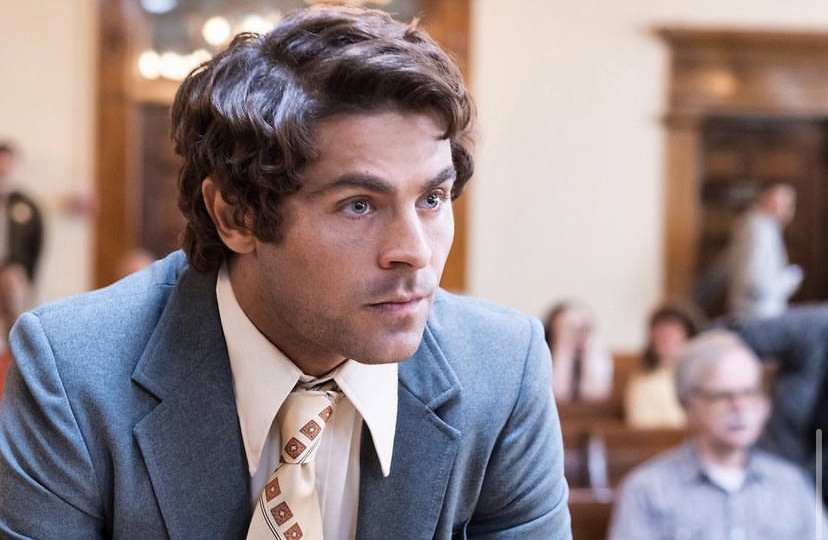The problematic nature of true crime: Celebrity actors make serial killers too palatable for the public
4 min read
Zac Efron as Ted Bundy in Netflix’s “Extremely Wicked, Shockingly Evil, and Vile.” | @zacefron, Instagram
by NATHALIE LUCIANO
Staff Writer
On Sept. 21, Netflix aired their limited series called “Monster: The Jeffrey Dahmer Story,” which joined the array of television shows and movies under the true crime subgenre already on the streaming service. After the show aired, some viewers—including the sister of one of Dahmer’s victims—immediately criticized the show, and rightfully so.
The true crime genre has received condemnation for the insensitive nature of the recollection and production of these traumatic events that get turned into entertainment for the masses. Using attractive, celebrity actors to portray serial killers makes them overly palatable, leading to infatuation on social media and further harm to the victims’ loved ones.
For “Monster: The Jeffrey Dahmer Story,” Netflix chose to cast Evan Peters, who is known for his work in the popular television series “American Horror Story.” Prior to this show, Peters had already garnered the internet’s infatuation as a heartthrob. His casting further explains how problematic these shows are, for they depict attractive and sought-after male celebrities as demented characters—a mistake that Netflix also made previously by casting teenage heartthrob Zac Efron to play serial killer Ted Bundy in another documentary: “Extremely Wicked, Shockingly Evil, and Vile.”
The foundational flaw of “Extremely Wicked, Shockingly Evil, and Vile” was the source material they based their project on Ted Bundy on. Instead of creating a respectable scope that based Bundy’s deeds through victims’ accounts, the writers for the show were inspired by “The Phantom Prince: My Life With Ted Bundy,” a memoir that was written by Elizabeth Kloepfer, a long-time girlfriend of Bundy. As a result, the docuseries was enveloped by an implicit bias, for Kloepfer’s memoir mainly covers the unraveling of their intimate relationship. This completely moves the focus away from his crimes and onto a story about a turbulent, romantic relationship whose ultimate end was Bundy’s “surprising” arrest.
This tragedy-turned-entertainment is also fomented online, especially on various social media platforms like TikTok. There are over one billion views under the hashtag “murdertok,” and many of the videos function as a social media whodunnit that hooks the user with cliffhangers and ominous sounds to set the tone for the story. This fantasizes traumatic events with the detachable nature of fiction, thus detaching the viewer from what they are watching. As a result, these videos romanticize the killer and their actions.
There are also videos that emphasize the attractiveness of serial killers and suggest that, due to their appearance, they were seemingly more trustworthy to their victims and therefore made their acts easier to commit. Some creators even went as far as to share their favorite murderers and highlight their facial and bodily attributes as their redeeming features, seemingly forgiving them because they were so attractive.
One such case was the Menendez brothers, who were sentenced to life in prison after killing their parents on Aug. 20, 1989. There are many TikToks that compile various “cute” and “sassy” moments the brothers had during their trial proceedings and others that relate Erik Menendez to being “the most attractive murderer in the world.”
HuffPost writer Zeba Blay suggests that these portrayals create a narrative that they are able to get away with their “unimaginably cruel acts for so long because [they were] exceedingly charming, clever and disarmingly handsome.” This is further emphasized when streaming networks cast individuals that exhibit such qualities, encouraging the popular infatuation the public has cultivated with these murderers.
Shows like these can also be extremely harmful to victims’ families. Iman Gatti, a grief recovery specialist who witnessed the traumatic event of her mother being killed by her own father, said, “Imagine the absolute worst torment that could ever happen to you being turned into entertainment for your friends and colleagues to watch with their favorite party snacks and then chat about, around the watercooler at work the next day.”
Rita Isabell, the sister of Errol Lindsey, one of Dahmer’s victims, described how the show has impacted her in a conversation with Insider.
“I was never contacted about the show,” Isabell said. “I feel like Netflix should’ve asked if we mind or how we felt about making it. They didn’t ask me anything. They just did it.”
When Isabell saw a portion of the show, naturally she was bothered to find an actress dressed just like her, her hair done the same way, giving the exact same impact statement she made verbatim when Dahmer went to trial. Isabell said, “That’s why it felt like reliving it all over again. It brought back all the emotions I was feeling back then.” Isabell’s comments further illustrate the blatant disregard the network demonstrated toward Isabell, her family and the families of other victims.
In addition to the lack of regard for those close to the victims, a major cost of making a murderer into a pop culture figurehead is the separation from their acts and the glorification of their name. Because Netflix and other streaming networks cast attractive individuals for these roles and play to their “good looks” to portray a killer, we will remember names like Bundy and Dahmer, but how many of us will remember the names of their victims?


